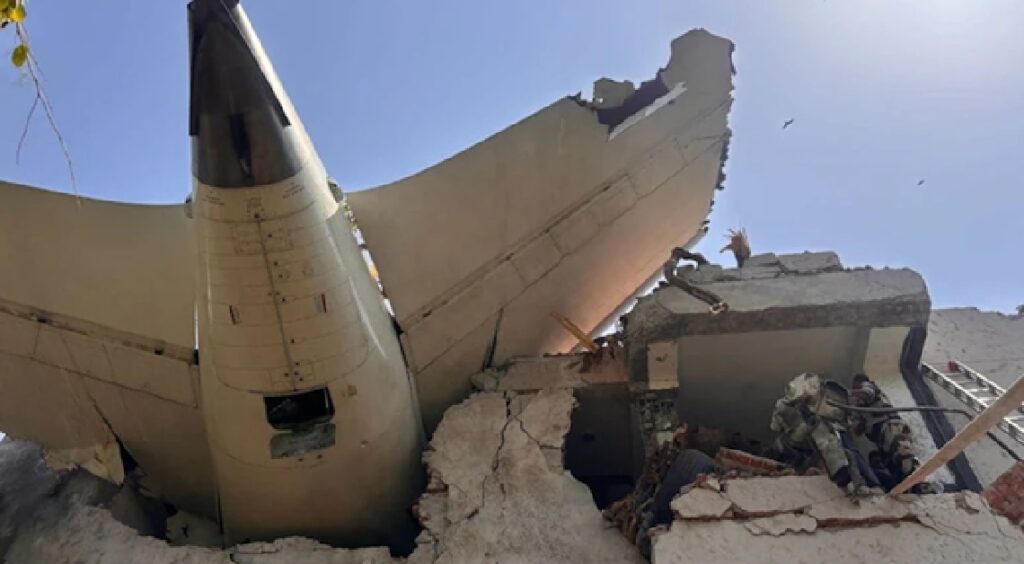Author: Akshay Published Date: June 13, 2025
The Harrowing Event
On June 12, 2025, tragedy struck when Air India Flight 171, a Boeing 787-8 Dreamliner, carrying 242 souls, crashed shortly after takeoff from Ahmedabad’s Sardar Vallabhbhai Patel International Airport, bound for London. In a split second—barely a minute in the air—the aircraft struggled to climb, issued a final “Mayday” distress call, and tragically came down into a medical college hostel on the ground.
Ground and Air Casualties
- On–board fatalities: 241
- Ground casualties and injuries: Including medical students and staff, bringing the total estimated casualties to over 245.
- Sole survivor: A British national, seated in exit row 11A, miraculously survived with minor injuries.
Witnesses describe a hellish scene—flakes of fire, thick black smoke, and guttural explosions that echoed through nearby buildings. Rescue teams, including NDRF, BSF, IAF, and local authorities, rushed to the site under desperate conditions
2. What Happened In The Air
The official timeline:
- 13:38 IST – Flight 171 takes off from Runway 23.
- Climbs slowly to about 625 ft; engine or power issues suspected.
- Pilot issues a final, urgent Mayday, then loses altitude rapidly.
- Crashes into the medical college campus with landing gear still down.
Analysts studying early flight radar tracks noted a sudden drop in altitude, suggesting a loss of thrust, possibly due to engine failure or mechanical fault. The presence of landing gear down during climb signals possible crew confusion or a rapid emergency braking situation. Fortunately, weather conditions were favorable, ruling out bad weather or pilot fatigue.
3. The Investigation Begins
A multi-agency team is actively probing:
- India’s AAIB is leading on-site investigations.
- Boeing and GE Aerospace have dispatched technical teams to analyze flight data recorders and potential engine anomalies.
- International collaboration with the US and UK aviation authorities is underway.
- With Boeing stock dipping nearly 5–9% in global markets, the manufacturer faces intense scrutiny.
FAA and DGCA pilot logs will be examined, along with maintenance records for this 11.5-year-old aircraft, model VT‑ANB, since its delivery in 2014.
4. Immediate Aftermath
- A no-fly zone was enforced around the airport; operations resumed later as investigations progressed.
- DNA tests were required for identification due to the severity of the crash.
- The PM of India and the UK expressed grief and condolences, citing it as “heartbreaking beyond words”.
- Tata Sons (Air India’s parent company) has pledged ₹1 crore per passenger to cover medical costs and the rebuilding of affected facilities.
5. Why This Matters
Aviation Safety Standards
- This is the first fatal Dreamliner crash in history—models known for reliability since their debut in 2011.
- It prompts re-examination of maintenance procedures, especially for aircraft in their second decade of service.
Airport Proximity Risk
Hospitals and hostels often cluster near airports. The fact that the impact was within seconds of takeoff highlights the potential for devastating ground casualties—a grim reminder for zoning and safety planning.
6. The Human Side
- The lone survivor, Vishwash Kumar Ramesh, has become a symbol of hope amid tragedy.
- His calm recollections during interviews—“I heard a loud bang, next moment I was outside”—are harrowing and profound.
- The loss includes Vijay Rupani, former Gujarat CM, and dozens of medical students and staff whose lives were shattered.
7. Looking Ahead
What to expect next:
- Preliminary report in the coming weeks—initial focus on technical faults.
- Root-cause analysis: Engine, software, crew protocols, and design review will form key parts.
- Safety recommendations (DGCA)—including maintenance audits, airport layout reviews, and takeoff procedures.
- Long-term reforms—improved emergency training and airspace management near densely populated zones.
8. Final Reflections
This crash is not just about machines—it’s about lives, communities, and lessons learned. As investigations continue, pressure is rising on airlines, airports, regulators, and manufacturers to elevate safety norms and ensure such a tragedy never repeats.
